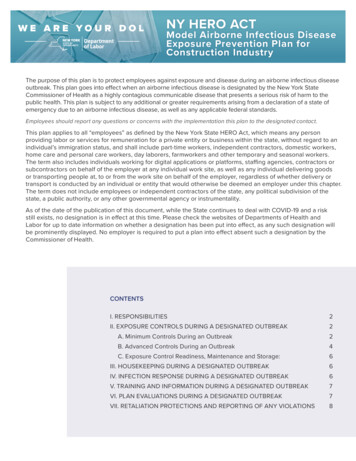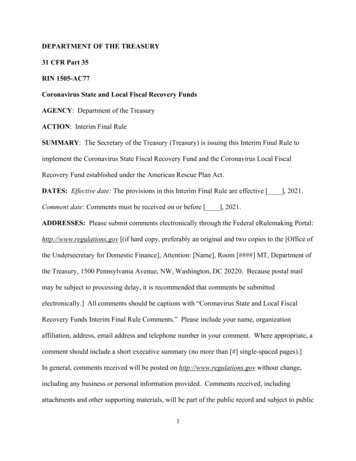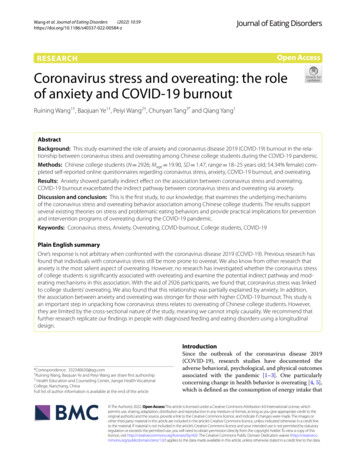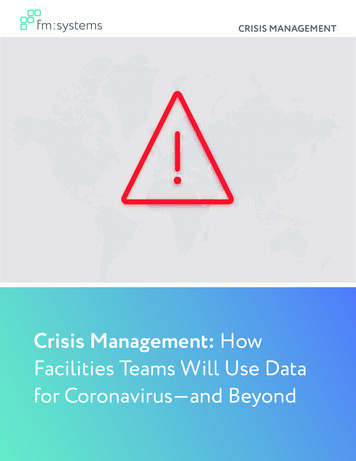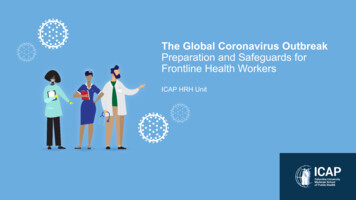
Transcription
The Global Coronavirus OutbreakPreparation and Safeguards forFrontline Health WorkersICAP HRH Unit
PurposeTHIS SHORT SLIDE SET provides rapid guidance for busy frontline health workers to preparethemselves, their staff and their facility for an increasing number ofCOVID-19 suspected and confirmed cases. outlines the key points and materials available through the WHO,CDC and others presents key information and job aides (There should be little needto create new materials. Focus on ACTION!) offers guidance on measures to safeguard the workplaceThe information included has been adapted from guidancerecently developed by WHO, CDC and others.As this is a rapidly evolving situation, we will be updating thisslide deck as new information and recommendations emerge.
PreparePreventProtectContain
Key Points PREPARE Our health centers, health workers and communities Prepare our staff and offices Clear consistent messages are needed for communities and staff Use a variety of means- radio, television, billboards and posters PREVENT Encourage social distancing / physical distancing Develop triage and isolation for those who are ill and guaranine for those exposed orrecently traveled from location with active COVID-19 spread Practice hand and cough hygiene, avoid touching your face PROTECT Protecting our human resources for health is essential to managing this outbreak Frontline health workers are at greatest risk because of the repeated close contactwith symptomatic patients CONTAIN Containing 2019-nCoV, the virus that causes COVID-19 disease is essential to limitrapid spread, safeguard health workers and persons at high risk of viral complications Aggressive containment measures can help to slow community-wide transmission andflatten the epidemic curve of this pandemic.
BackgroundA novel virus with a zoonotic originThe name of the virus is Severe Acute Respiratory SyndromeCoronavirus 2 (SARS-CoV-2 or 2019-nCoV)The name of the disease is Coronavirus Disease 2019 (COVID-19)Spread Person to person through close contact Respiratory droplets from a cough or sneeze It is possible that transmission could occur from someone who isasymptomaticCauses mild to severe-life threatening disease Risk factors for severe illness include increased age, male genderand comorbidities such as hypertension, diabetes and coronary heartdisease Viral shedding- median duration 20 days (Zhou et al, March 9, 2020,The action/showPdf?pii S0140-6736%2820%2930566-3J.S.M. Peiris, Medical Microbiology, 2012
Where to go for up to date informationGo to (source: https://coronavirus.jhu.edu/map.html)for the latest information on COVID-19 numbersincluding, number of confirmed cases as well asinformation on the geographic spread of the disease
Data as of March 24, 2020source: https://coronavirus.jhu.edu/map.htmlThe map in the middlehelps to show how rapidlyand widely this novel virushas spread since firstbeing reported in Wuhan,China in December 2019
How does COVID-19 spread?When someone who has COVID-19 coughs orexhales the mouth releases droplets of infectedfluid. Most of these droplets fall on nearby surfacesand objects - such as the floor, desks, tables ortelephones.If someone is standing within one meter of aperson with COVID-19, he or she can becomeinfected by breathing in infected droplets coughedout or exhaled as shown in the image to the right.People may also be exposed to COVID-19 bytouching contaminated surfaces or objects – andthen touching their eyes, nose or mouth. Althoughthis is less likely, studies show that the virus canlive on surfaces for extended periods of time.
WHO COVID-19 Case Definitions (27 February 2020)Suspected case A person who presents with an acute respiratoryillness (fever and cough or shortness of breath) ANDno other cause that fully explains the clinicalpresentation AND a history of travel to or residence ina country, area or territory that has reported localtransmission of COVID-19 disease during the 14 daysprior to symptom onset or A patient with any acute respiratory illness AND whohas been a contact of a confirmed or probable case ofCOVID-19 disease during the 14 days prior to theonset of symptoms OR Surveillance for humaninfection with novel coronavirus: or A patient with severe acute respiratory infection (feverand cough or shortness breath) AND who requireshospitalization AND who has no other etiology thatfully explains the clinical presentation.Probable case A suspected case with aninconclusive 2019-nCoV lab testConfirmed case Laboratory confirmation of infectionwith the COVID-19 virus irrespectiveof clinical signs and onavirus-(2019-ncov)
Everyone is at riskSince this is a novel (new) virusno one has natural immunityRisk of serious illness rises with: Age - people over 40 seem to be morevulnerable than those under 40. People with weakened immunesystems and people with underliningconditions such as diabetes, heart andlung disease are also more vulnerableto serious illness.
What are the symptoms? Most persons infected withCOVID-19 experience mildsymptoms and recover. However, some go on toexperience more serious illnessand may require hospital care.
PreparePreventProtectContain
PREPARE the Public for COVID-19Provide orientation to all healthfacility staffInformation sharing on radio SpotsTelevision and NewspaperDissemination of key information tocommunity leaders, traditionalchiefs, healers, etc.Use pictures and local languagewhenever possibleFocus on key messages Consistent & ClearDispel myths quicklyUNICEF (March 2020). Guidance for COVID-19Prevention and Control in Schools
PREPARE the Workplace for COVID-19Make sure your workplaces areclean and hygienic Surfaces (e.g. desks, chairs andtables) and objects (e.g. telephones,keyboards) need to be wiped withdisinfectant regularly. Surfaces that are frequently touchedby many people such as doorknobs,toilets, faucets and sinks should bedisinfected frequently.Why? Because contamination onsurfaces touched by employees andclients is one way that COVID-19can spread.Disinfectant: 75% alcohol, chlorine, diethyl ether,peroxyacetic acid, chloroform, 56 for 30 minutes
PREPARE the Clinic to Implement TRIAGETriage should beginoutside the health facilitySet up a screeningarea for all clients Create hand washing stations Post IEC materials Train health workers toassess for symptoms Create a separate waitingarea for suspected cases Enact social distancing people should stand orsit at least one metre apartCheck for CoughFeverShortness of BreathDifficulty Breathing
Screening ChecklistExample from: The Second Affiliated Hospital, ZhejiangUniversity School of Medicine, Hangzhou China
WHO. 10 March 2020 The COVID-19 Risk Communication Package for Healthcare Facilities
A New Resource for Clinical Coordination ARTICLE SeekingEvidence-Based Covid-19Preparedness: A FEMA Framework for ClinicManagementJennifer M. Schmidt, MD Vol. No. March 25, 2020 DOI: 10.1056/CAT.20.0079 Clinicians seek to use evidence-based guidelines. How should leaders respond when there areno best practices? An academic general medicine clinic in St. Louis, Missouri, adapted theFederal Emergency Management Agency’s Incident Command System to manage itsoperations during the fast-changing Covid-19 pandemic. Originally used to fight wildfires,
Preventing the Spread of colds, flu,stomach bugs and viruses like COVID -19Ensure the workplace is clean and hygienic Clean desk surfaces and conference tables Ensure telephones, keyboards and floors aredisinfected regularlyHOW DOES THIS PREVENTTHE SPREAD OF COVID-19? Many people touching the same surfaces thathave been contaminated with COVID-19 are akey source of how the infection spreadsImage Reference: ronmental-cleaning-508.pdf
PreparePreventProtectContain
Stop the chain of transmission earlyImage Reference: ronmental-cleaning-508.pdf
PREVENT SPREAD of COVID-19 Increase access to handwashingstations and/or hand sanitizer Cover the cough Practice social distancing Encourage workers to stay home if ill Ensure community myths are quicklydispelledUNICEF (March 2020). Guidance for COVID-19Prevention and Control in Schools
PREVENT: Hand HygienePromote regular and thoroughhand-washing by employees,contractors and customers Put sanitizing hand rub dispensers inprominent places around the workplace. Makesure these dispensers are regularly refilled Display posters promoting hand-washing – askyour local public health authority for these orlook on www.WHO.int. Make sure that staff, contractors andcustomers have access to places where theycan wash their hands with soap and water
Excellent Handwashing Video https://www.youtube.com/watch?v cbX0xwKORjk
PREVENT: Respiratory HygienePromote good respiratory hygienein the workplace Display posters promoting respiratoryhygiene. Combine this with othercommunication measures such asoffering guidance from occupationalhealth and safety officers, briefing atmeetings and information on theinternet. Ensure that face masks and papertissues are available at yourworkplaces, for those who develop arunny nose or cough, along with closedbins for hygienic disposal. Teach patients to cover their cough withtheir elbow
PREVENT: Respiratory HygieneFace masks must be used properlyto ensure that they are effective inprotecting health care workers.
PREVENT: Respiratory HygieneFace masks must also be disposed ofproperly and frequently to ensure thehealth and safety of health care workers.
PreparePreventProtectContain
Health care workers (HCW) are our frontlineof protection -- We need to protect themTRAIN HCW in COVID-19 triage,IPC and case managementMONITOR fidelity to IPC standardsSUPPORT access to adequatematerials, time to rest andpsychosocial support
PROTECT: Frontline Health Workers Provide PPE Masks, Goggles, Gowns and Handwashing stationsTrain health workers to identify symptoms andtake measures to keep themselves and others safeProvide Screening Checklists Outdoor triage with patient flow diagrams to isolatesuspected cases Encourage health workers to employ a buddy system foroptimal PPE use and protection Provide suspect cases with a mask to protect others, thislimits the spread of the virus If no mask is available, teach cough hygiene and isolate If isolation is not possible, ensure at least 1 metre spacebetween people Remind patients they have an important role to play inlimiting spread
How to manage risksKeep employees informed If COVID-19 has been suspected in thecommunity, advise anyone with cough, lowgrade fever (37.3 C or more) to stay home orwork from home Keep promoting “stay at home” even if mildsymptoms Display messages in the officePostpone large meetings and events Consider whether the meeting needs to takeplace or if it can be done via teleconference If the meeting is required, consider reducing thenumber of people Check with community authorities where themeeting is being heldFeeling Sick?Stop the spread of virusesin the workplaceSTAY AT HOME
How to manage risks: MeetingsMeetings and Events Ensure supplies of hand sanitizers and tissues forparticipants and locate these in areas most frequented byparticipants Ask participants to refrain from attending the meeting inperson if they feel unwell – make teleconference availablefor these participants Collect participant attendance information Provide participants with information on where to accesshealth services if they get sick Have a plan in place in the event someone gets sick Have participants sit at least one meter apart Ensure proper ventilation by opening windows Retain participant information for at least one month postmeeting This information can be helpful in the event someone isexposed to COVID 19
How to manage risks: If someone gets sickSelf Isolation If you’ve been in contact with someone who has beensuspected of COVID-19, stay at home and monitor yoursymptoms Monitor temperature daily for 14 days If mild symptoms are present (cough, low grade fever(temp 37.3 C or more), stay home and avoid close contactwith other people including family members. If symptoms develop after travel or attending a meeting,inform your employer and public health department givingthem details of your travel /meeting attendance
PreparePreventProtectContain
CONTAIN: What to do when someone arrives with COVID-19 Triage Screenand Test ContainA site plan should include putting theill person in a room or area where theyare isolated from others in theworkplace, limiting the number ofpeople who have contact with the sickperson and contacting the local healthauthorities. Consider how to identify persons who maybe at risk, and support them, without invitingstigma and discrimination into yourworkplace.Stop Stigma
CONTAIN: Placement of the sick Separatesuspect fromconfirmed cases Keeppatients 1 metre apart Placeonly one person perbedrooms for eachpatient if possibleAdequate VentilationOpen Windows SeparateMasksPeople placed at least 1metre apartWHO March 10, 2020 WHO COVID-19 Risk Communication
In summaryEnsure workplace is cleanand hygienic Clean desk surfaces andconference tablesEnsure telephones, keyboardsand other commonly touchedsurfaces are disinfectedregularlyPromote Hand Washing Display posters promoting handwashing in local language Promote Respiratory Hygiene Use pictures and demonstrationwhenever possibleDisplay posters promoting respiratoryhygiene (sneezing and coughing intoelbow) Place hand sanitizers in areas that arefrequently visited (conference rooms,reception area, bathroomsEnsure availability of tissue boxesand closed garbage bins to disposeof tissues Wash hands or use hand sanitizerafter blowing nose/sneezing orcoughing into handsEnsure staff, including workers andcontractors can access places wherethey can wash their hands - place washbasins with soap throughout the facility.Place more than you think you willneed. Handwashing is a first line ofdefense.
Helpful websitesWorld Health Organization Coronavirus disease (COVID-19) ovel-coronavirus-2019Center for Disease Control ov/index.htmlNational Institute of Health “Protecting Yourself from COVID-19 in the c/hasl get blob.cfm?ID 11781CDC “Managing Anxiety and /prepare/managing-stress-anxiety.htmlCDC “Infection Prevention and Control .html?CDC AA refVal %2Fhcp%2Finfection-control.html
WHO/CDC Posters
WHO Posters
WHO Posters
Psychosocial Support- Top 12 Tips to Relieve COVID-19 Stress1.2.3.4.5.6.7.8.9.10.11.12.First, rest assured you are not aloneSet aside time to breatheKnow it is OK to ask for helpFocus on the good and provide acts of kindnessFind a mantraThis is a marathon not a sprintThis is a tough time and we will get through itKnow timing is everythingStay informed by using reliable resourcesFocus on what you can do and what is in your controlFind ways to stay socially connectedSet daily routinesWrite it outExplore apps that benefit mental abit.com/Reference covid-19-stress-relief
Protect health care workers mental health Key messages Healthcare staff are at increased risk of moral injury and mental health problems when dealing withchallenges of the covid-19 pandemic Healthcare managers need to proactively take steps to protect the mental wellbeing of staff Managers must be frank about the situations staff are likely to face Staff can be supported by reinforcing teams and providing regular contact to discuss decisions andcheck on wellbeing Once the crisis begins to recede, staff must be actively monitored, supported, and, where necessary,provided with evidence-based treatmentsReference: BMJ 2020;368:m1211 doi: 10.1136/bmj.m1211 (Published 26 March 2020)
Psychosocial Support Resources (1)Centers for Disease Control and Prevention Emergency Responder Tips for Taking Care ofYourself (CDC) Managing Anxiety and Stress (CDC)American Foundation for Suicide Prevention Protecting your Mental Health During theCoronavirus OutbreakUniformed Services University – Center for the Study For guidance on talking to (your) family about COVID19of Traumatic Stress The American Academy for Child and Adolescent Facts sheets for Providers, Families, LeadersPsychiatry AACAP Coronavirus Resources for Parents, YouthAmerican Psychiatric Associationand Clinicians APA Resources for Providers, Families andHealthcare LeadersNational Child Traumatic Stress Network (NCTSN)American Psychological Association Seven Research Findings that can help People Deal Taking Care of Family Well-Beingwith COVID-19
Psychosocial Support Resources (2)Interviews, blogs from Columbia faculty, etc.Remember practice self care, eat well, rest, talk Coping with Anxiety and Stress in the Age of Exercise when you have no timeCoronavirus (featuring Anne Marie Albano, PhD) Mental Health First Aid for First Responders(Deborah Glasofer, PhD)Apps/Videos Mindfulness and meditation Headspace (currently free for healthcareproviders), Calm, Insight Timer Cognitive Behavioral Strategies Mood Gym Daily Mood Ratings Daylio, iMoodJournal
Prevention and Control Recommendations- Hangzhou ChinaSet up 10 Working Teams1. COVID-19 Experts (clinical and hospital infection control)2. Patient Services Coordination3. Epidemiological Investigation and Quarantine4. Medical Equipment and Supply5. Human Resource Deployment6. Employee Care7. Public Relations and Media Coverage8. Data Collection and Archiving9. Social Donation10. Supervision and InspectionReference: Preventive and Control Measures for COVID-19- SAHZU Experience, The Second AffiliatedHospital Zhejiang University School of Medicine Hangzhou, China March 13, 2020.
Thank you.
Protecting our human resources for health is essential to managing this outbreak . An academic general medicine clinic in St. Louis, Missouri, adapted the Federal Emergency Management Agency's Incident Command System to manage its operations during the fast-changing Covid -19 pandemic. Originally used to fight wildfires,



